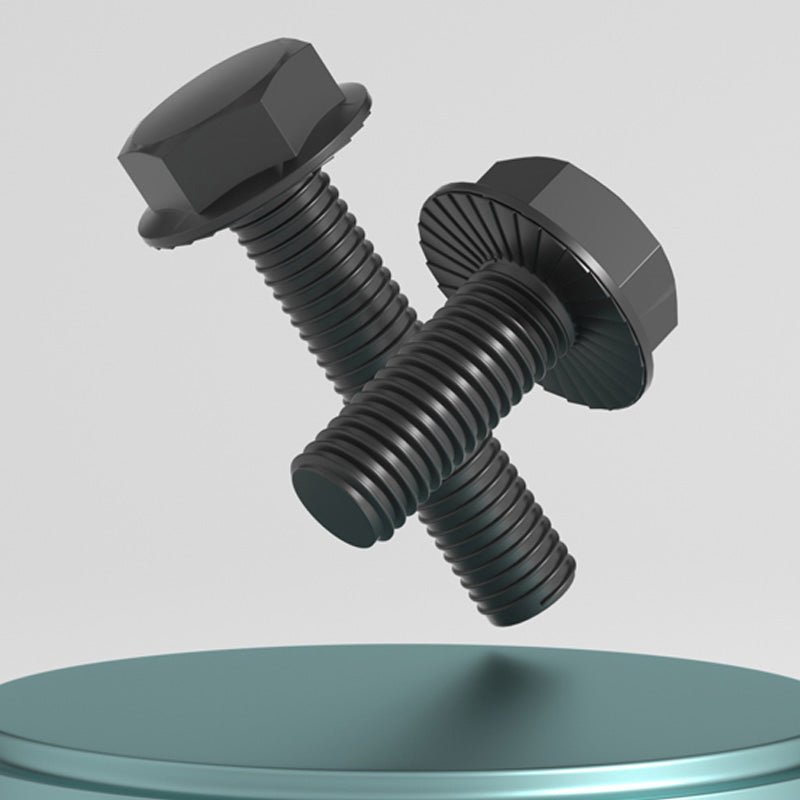1. Product core introduction
HomeDIYer Black Hexagon Head Flange Screws, made of grade 10.9 alloy steel in sizes ranging from M6 to M16, are flange bolts with anti-loosening feature. Designed to provide you with a reliable and solid fastening solution, the flange design helps to enhance load distribution and stability, and the alloy steel material ensures durability and strength for a variety of applications that require a secure connection.
2. The main characteristics of the product
High-strength alloy steel material: 10.9 grade alloy steel is selected, with excellent strength and hardness, capable of withstanding large tensile and shear forces, ensuring the reliability and stability of the bolted connection under various complex working conditions. Whether in the assembly of machinery and equipment, the connection of building structures or the installation of industrial facilities, it can effectively resist external forces and prevent bolts from loosening or breaking, providing a solid guarantee for the safe operation of the entire system, prolonging the service life, and reducing the maintenance costs and potential safety hazards due to the failure of bolts.
Reliable anti-loosening design: Equipped with special anti-loosening devices, such as nylon inserts, thread locking agent coating or special thread structure, etc., it can effectively prevent the bolts from loosening during vibration, impact or long-term use. This kind of anti-loosening design is crucial for some occasions that need to maintain a long-term stable connection, such as automotive engine components, railway track connections, bridge structures, etc. It can significantly improve the reliability of the connection, reduce the risk of failures caused by loose bolts, ensure the normal operation of equipment and facilities, and safeguard the safety of personnel and property.
Optimised flange structure: The unique flange design increases the contact area between the head of the bolt and the connected parts, which can better disperse the pressure and prevent local stress concentration, thus improving the stability and sealing of the connection. In some applications where sealing performance is required, such as pipeline connection, pressure vessel sealing, etc., flange bolts can effectively prevent medium leakage, ensure the safety and normal operation of the system, and at the same time reduce energy waste and environmental pollution caused by poor sealing.
Precise size: Providing a wide range of sizes from M6 to M16, they can meet the fastening work of different size requirements and ensure precise matching with various standard and non-standard nuts, studs and connected parts. Whether it is precision assembly of small electronic equipment or heavy-duty connection of large industrial equipment, you can find the right specification of flange bolts to achieve precise and tight connection, improve work efficiency and connection quality, and reduce installation difficulties and safety hazards due to mismatch of sizes.
3. Product use scene
Machinery Manufacturing and Maintenance: In the manufacturing process of all kinds of machinery and equipment, such as machine tools, engineering machinery, automotive parts, etc., it is used for the connection and fixation of key components. Its high-strength and anti-loosening characteristics can ensure that the equipment in high-speed operation, severe vibration conditions, the connection between the components is firm and reliable, to avoid equipment failures and safety accidents caused by loose bolts, to improve the overall performance and reliability of the equipment, to extend the service life of the equipment, to reduce the number of times and costs of maintenance, and to protect the continuity and stability of production.
Architectural and structural engineering: widely used in the erection of architectural steel structures, the construction of bridge projects and the connection of pre-embedded parts in concrete structures. In these large-scale architectural and structural projects, flange bolts are able to withstand huge tension and pressure to ensure the stability and safety of the structure. At the same time, its anti-loosening performance is crucial to safeguard the structural integrity of the long-term use of the process, effectively preventing the bolt from loosening due to wind, earthquakes, vehicle travelling and other factors, to provide a reliable guarantee for the safety of the buildings and infrastructure, and to reduce the casualties and economic losses due to structural damage.
Energy and power industry: In the energy field such as power plants, substations, oil and gas extraction and transmission, it is used for the installation of equipment and the connection of pipelines. For example, in the assembly of large equipment such as generators, transformers, boilers, etc., flange bolts can ensure the precise installation and stable operation of the equipment, prevent the loosening of bolts due to vibration and thermal expansion and contraction, and safeguard the reliability of power supply. In the connection of oil and gas pipelines, its good sealing performance can effectively prevent oil and gas leakage, protect the environment and resources, ensure the safe transmission and use of energy, and meet the strict requirements of the energy industry for the reliability and safety of equipment connection.
4. Product use instructions
Preparation before installation:
Check the appearance of flange bolts for cracks, deformation, thread damage and other defects to ensure that the product quality is intact. At the same time, check whether the matching nuts, washers and other accessories are complete and match the specifications, if there is any problem, contact the supplier for replacement in time, so as not to affect the installation effect and connection strength.
According to the material, thickness and connection requirements of the connected parts, select the flange bolts with appropriate specifications and determine the appropriate tightening torque. Generally speaking, the product manual or relevant standards will provide the recommended range of tightening torque, users should operate in strict accordance with the requirements, to avoid connection failure or bolt damage due to too large or too small tightening torque.
Use a cleaning cloth or solvent to clean the threaded holes of the connected parts and the threaded parts of the bolts to remove impurities such as oil, rust, dust, etc., to ensure good meshing between the threads, so as to improve the reliability of the connection and anti-loosening performance.
Installation steps:
Pass the screw part of the flange bolt through the mounting hole of the connected part, and make sure that the flange surface of the head of the bolt and the surface of the part fit tightly and flatly, without skewness or gap. If necessary, a washer can be added between the head of the bolt or the connected part to adjust the mounting gap or increase the friction to improve the stability and sealing of the connection.
Screw in the matching nut on the screw, use suitable tools (such as spanners, torque wrenches) to tighten the nut gradually according to the specified tightening torque to ensure that the bolt generates sufficient preload between the connected parts. In the process of tightening, pay attention to the uniform application of force to avoid unilateral tightening resulting in uneven force on the connected parts or bending and deformation of the bolts. For the connection of multiple flange bolts, they should be tightened sequentially in diagonal or cross order to ensure uniformity and sealing of the connection.
If the bolts are equipped with special anti-loosening devices (e.g. nylon insert nuts), check whether the anti-loosening devices are installed correctly and effectively after tightening the nuts to ensure that they can play the role of anti-loosening in the process of use and prevent the bolts from loosening due to vibration and other factors.
Precautions for use:
During the use of the equipment or structure, regularly check the connection status of the flange bolts to see if there are signs of loosening, deformation, corrosion, etc.. Especially after the equipment has been in operation for a long time, subjected to severe vibration or changes in environmental conditions (e.g., large fluctuations in temperature and humidity), it is more important to strengthen the inspection efforts. If the bolts are found to be loose, they should be re-tightened in a timely manner using suitable tools in accordance with the specified tightening torque to ensure the reliability of the connection; if the bolts are found to be corroded or damaged, they should be replaced with new bolts in a timely manner, so as to avoid safety accidents triggered by the failure of the bolts.
Avoid excessive impact or overloading of the flange bolts, which may lead to bolt breakage or damage of the connected parts. When designing and using the equipment or structure, the bearing capacity and working conditions of the bolts should be fully considered, and the bolt specifications and connection methods should be reasonably selected to ensure that the bolts are used within the normal working range and to improve their service life and safety.













